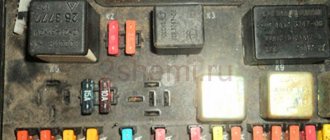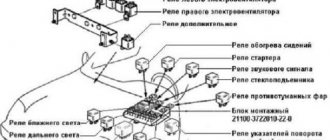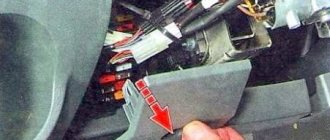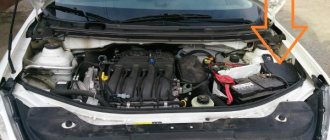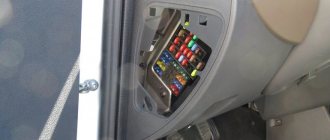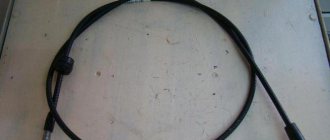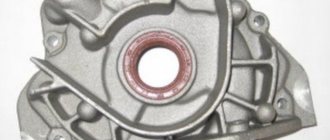Scheme
The entire line of VAZ 2109 cars can be divided into two branches - those produced before 1998 and those produced after 1998.
Older cars are equipped with fuse blocks whose marking is 17.3722. This power supply consists of a housing and an engineering board. Wire contacts, fuses and relays are soldered to the board.
Newer versions of nines, the production of which began in 1998, here the power supply is marked 2114-3722010-60. Here we are already seeing fuses.
If we talk about fuse blocks, the factor of the fuel injection system used - carburetor or injector - plays absolutely no role. BP will differ only by the year of manufacture of the car. Therefore, the mounting blocks for the carburetor and injector are the same.
The required mounting block is also located the same everywhere - in the engine compartment opposite the driver's seat, almost under the windshield.
Differences
Are there any differences between the old and new versions of the power supply? Of course. They are as follows:
- The parts of the mounting block are marked differently;
- The fuse ratings are different;
- The new power supply does not have a relay for the cooling system fan motor and a time relay for the rear window washer device.
Old style power supply
Let's first consider the old-style power supply units, which are still quite often found on VAZ 2109 cars. Moreover, as we have already said, with both injection and carburetor engines.
| Fuse number | Current strength | The chain he protects |
| F1 | 10A | Backup fuse |
| F2 | 10A | Turn signal indicators, hazard signal breaker (in hazard mode), hazard warning light |
| F3 | 10A | Rear brake lights, interior lighting |
| F4 | 20A | Rear window heating element, rear window heating switch contacts, carrying socket, cigarette lighter |
| F5 | 20A | Horn (horn), horn switch |
| F6 | 30A | Backup fuse |
| F7 | 30A | Heater fan electric motor, windshield washer electric motor, electric radiator fan relay, rear window heating relay, rear window heating indicator light, glove box light |
| F8 | 7.5A | Backup fuse |
| F9 | 7.5A | Backup fuse |
| F10 | 7.5A | Left side light |
| F11 | 7.5A | Right side lamp |
| F12 | 7.5A | Right low beam headlight |
| F13 | 7.5A | Left low beam headlight |
| F14 | 7.5A | Left high beam headlight, high beam indicator lamp |
| F15 | Right high beam headlight | |
| F16 | 15A | Turn signal indicators and emergency flasher relay-breaker (in the turn signal indication mode), turn signal indicator indicator lamp, rear reverse lights, gear motor and windshield wiper activation relay, oil pressure indicator lamp, hand brake indicator lamp, coolant temperature indicator, fuel level indicator, fuel reserve warning lamp, voltmeter |
BP 17.3722
Relay
In addition to the fuse designations, it will be useful for you to know which relay number in the mounting block is responsible for which functions.
| Relay number | Functions |
| 1 | Performance of the front optics cleaning elements |
| 2 | Rear window washer motor performance |
| 3 | Protection against breakage of turn signal and light signaling lamps |
| 4 | Protection against failure of the windshield wiper motor |
| 5 | Allows you to determine the performance of the lamp |
| 6 | Rear window defogger overvoltage protection |
| 8 | High beam lamps |
| 9 | Low beam lamps |
| 11 | Responsible for the operation of the engine cooling fan. If this relay fails, the risk of engine overheating increases. |
| 12 | Klaxon operation |
Old PSU
The “dimensions” do not light up on the VAZ 2108, 2109, 21099
Let's look at how to quickly find the reason for the failure of the "dimensions" on VAZ 2108, 2109, 21099 cars. The side lights are part of the vehicle's external lighting system and its operation with non-functioning "dimensions" is difficult, especially at night. We are looking for the reason for the non-functioning dimensions, as is customary in such situations, from simple to complex.
Causes of the malfunction “the dimensions of the VAZ 2108, 2109, 21099 do not light up”
The side light bulb in the socket has burned out
One light bulb, or several at once, can suddenly burn out. In some cases, it may be impossible to visually identify a burnt-out light bulb. Therefore, we replace the burnt out one with a known good one. You can use a similar one from a nearby headlight.
The contacts in the side light bulb socket have oxidized.
We rotate the light bulb in the socket several times to remove the oxidized layer and restore contact. In the future, you can clean everything with sandpaper.
The contacts in the connecting blocks of the headlight or tail light unit have oxidized
We remove and put on the connecting blocks several times to remove the oxidized layer and restore contact. More radically, we remove the pads and clean the contacts.
No "mass"
The “negative” wires of the front headlights and rear lights with side lights on VAZ 2108, 2109, 21099 cars are attached to the car body. It is necessary to clean the mounting location to ensure good contact with ground. Usually the negative wire is the black wire from the headlight connection block, attached to the body next to the headlight or taillight.
Weight of the front headlight, place of attachment to the body of the VAZ 2108, 2109, 21099
Fuse blown
If fuse 10 (F11) is blown, the side lights of the right headlight and right rear light will not work. If fuse 9 (F10) is blown, the left headlight and left rear light of the vehicle will not work. We replace them with new ones, and then look for the cause of the burnout (possibly a short circuit somewhere).
Relay K4 is faulty (monitoring the health of the lamps)
A faulty K4 lamp control relay can be replaced with jumpers. We connect the holes for relay terminals 1-7-8, 9-10-11, 4-5. On some VAZ 2108, 2109, 21099 vehicles, jumpers are already installed instead of lamp health monitoring relays.
The tracks in the rear light circuit boards have crumbled
Visually inspect the tracks in the rear light circuit boards for shedding, rust, or burnout. If necessary, we check their integrity using a test lamp or tester. A faulty track can be repaired by soldering wire onto its frayed edges.
The pads in the mounting block have come off or the wire tips have oxidized.
It is necessary to check the secure fit of the connecting blocks in the fuse mounting block. For an electrical circuit of “dimensions” these are plugs Ш4 (Х4), Ш6 (Х6), Ш9 (Х9), Ш11 (х11). If necessary, the wire tips present in them should be cleaned from oxidation.
The external lighting switch on the instrument panel is faulty
You should remove the exterior lighting switch and connect the black and yellow-red wires together. The black current flows into the switch, and the yellow-red current flows out. If the lights light up, replace the switch with a new one. If not, we look for a fault in the electrical circuit further.
"Outer light switch"
"Open" or short circuit in the wiring
It is necessary to check the presence of electric current on the external lighting switch (circuit from the ignition switch to the switch), fuses (circuit switch - mounting block) and on the lamp control relay (functionality of the mounting block).
See “Electrical connection diagrams for turning on side lights (exterior lighting) on VAZ 2108, 2109, 21099”,
"How to find a break in a car's electrical wiring."
Notes and additions
— Side light lamps are located in the front headlights and rear lights of the car. The front lights use an A12-4-1 bulb, and the rear lights use an A12-5 bulb.
— The electrical circuit for switching on the external lighting (“dimensions”) is the same for all these cars. The only difference is in the fuse mounting blocks used: on old Samaras, before 1999. this is 17.3722 with finger fuses, on cars after 1999. modifications of the mounting block 2114 with flag fuses. Accordingly, fuses 9 and 10 are used in the external lighting circuit with the old mounting block, with the new F10, F11.
— “Dimensions” of the right side of VAZ 2108, 2109, 21099 cars on the 10th (F11) fuse. “Dimensions” of the left side on the 9th (F10) fuse.
Twokarburators VK - More information on the topic in our VKontakte group, on Facebook Twokarburators FS and on Odnoklassniki - Twokarburators OK
More articles on electrical VAZ 2108, 2109, 21099
— Electrical connection diagram for the reversing light on VAZ 2108, 2109, 21099 cars
— Electrical connection diagram for brake lights and parking brake of VAZ 2108, 2109, 21099 cars
— The reverse light does not light up on VAZ 2108, 2109, 21099 cars
— Contacts of steering column switches on VAZ 2108, 2109, 21099 cars
— Turn indicators do not work on VAZ 2108, 2109, 21099 cars
— How to remove the headlight of VAZ 2108, 2109, 21099
New model power supply
Here the mounting block diagram is arranged a little differently, but it is more relevant for owners of the VAZ 2109, since most of the nines that have survived to this day are modernized versions.
The scheme is relevant for both carburetor and injection types of engines.
| Fuse number | Rated current | The electrical circuit for which it is responsible |
| 1. | 8A | Backup fuse |
| 2. | 8A | Backup fuse |
| 3. | 8A | Backup fuse |
| 4. | 16A | Radiator fan relay winding, electrical circuit of switch and heater motor |
| 5. | 3A | Hazard warning switch in turn signal mode, turn signal switch, turn signal switch, turn signal warning light, turn signal warning light, reverse optics switch, reverse lights, tachometer, voltmeter, gasoline level indicator, gasoline level sensor, gasoline level warning light, pointer coolant temperature, temperature sensor, warning lamp and emergency oil pressure sensor, brake emergency lamp, brake system hydraulic switch, hand brake switch |
| 6. | 8A | Brake light switch and bulbs, interior lighting |
| 7. | 8A | Room lighting lamps, indicator lamp for switching on the dimensions, lamp for illuminating the heater and cigarette lighter handles, glove compartment lamp, switch and lamp for instrument panel illumination |
| 8. | 16A | Horn, horn switch, radiator fan motor |
| 9. | 8A | Left side lamp, left rear side lamp |
| 10. | 8A | Right side lamp, right rear side lamp, fog light switch, fog light indicator light |
| 11. | 8A | Turn signal switch and breaker, turn signal lamps, warning lamp in emergency mode |
| 12. | 16A | Cigarette lighter, socket for carrying lamp |
| 13. | 8A | High beam right headlight |
| 14. | 8A | Main beam of the left headlight, high-range optics warning lamp |
| 15. | 8A | Low beam right headlight |
| 16. | 8A | Low beam left headlight |
Relay
As for the relay in the mounting block of the new model for the VAZ 2109, the pinout is as follows.
| Relay number | Its functions |
| K1 | Without it, the rear window washer motor will not work. |
| K2 | Responsible for the operation of turn signal lamps and light signaling |
| K3 | Provides operation of the windshield wiper |
| K4 | Protects brake lights and vehicle dimensions |
| K5 | Provides operation of high beam lights |
| K6 | Guarantees operation of the optics washer device |
| K7 | Protects the power window motor if your vehicle has one. |
| K8 | Sound signal or just a horn |
| K9 | Protects against high voltage going to the engine cooling fan |
| K11 | Responsible for the operation of the rear window heating device |
| K12 | Provides operation of low beam lights |
It is necessary not only to understand the location of a particular fuse or relay, but also to know how to replace a failed element.
Checking the cooling system
What to do if the VAZ 21099 carburetor cooling fan does not work? As soon as the car owner noticed the first signs of overheating, i.e. the temperature sensor arrow has approached the red zone, but the carburetor has not yet started pouring smoke from under the hood of the VAZ 21099, you need to check the cooling system.
Check all wire connections
Step-by-step instructions for checking the cooling system.
READ How to Connect a Fan Directly VAZ 2109
Dismantling and replacement
If one or another equipment fails, you must first check the condition of the fuse responsible for it.
In practice, removing and removing an unusable fuse or relay is not difficult. To do this you need:
- Raise the hood and disconnect the minus from the battery. Since you are working with the fuse box responsible for electrical equipment, the car should not be energized at this moment;
- Find the mounting block. It is located in the engine compartment opposite the driver's seat directly under the windshield. The top of the block is covered with a plastic cover. To remove it, simply press the latches on the sides;
- Remove the cover and look at the back side. There is an electrical diagram showing the location of one or another fuse or relay. Just find the element that is responsible for the failed equipment according to the tables above;
- Remove the fuse. All mounting blocks are equipped with special pliers. Manually removing fuses is not recommended. The relays are removed by gently rocking up and down;
- Replace the failed component.
Fuse failure is determined by the melted filament. These are fusible elements that melt and make contacts, preventing equipment from being damaged by excessive voltage.
That's it, all that remains is to replace the fuse block element, close the cover, replace the battery terminal and check the functionality of the equipment.
How to check the serviceability of VAZ 2108 fuses
If a circuit overload occurs in a VAZ 2108 car, one or more fuses interrupt the circuit and fail. However, if an electrical device stops working, it is far from certain that the problem is in the fuse. In this case, the right solution would be to diagnose the element in the fuse box that is responsible for a specific electrical device.
It is easy to determine which fuse has failed using the car's instructions. It contains a “map” that shows where the elements responsible for a particular electrical device are installed in the fuse box. Using this map, the location of the fuse is determined, due to which the circuit of the electrical device could be de-energized, and then it is necessary to diagnose its fuses.
In order to check the serviceability of the VAZ 2108 fuse, you must:
- Conduct a visual inspection of the fuse for a break.
- Check the fuse with a multimeter
- To test a circuit element, a common device is used - a multimeter, also known as a tester. The device is indispensable for the car enthusiast, and it allows you to check the car fuse in two ways. (voltage test and resistance test)
VAZ 2109 fuses: where they are, replacement
Unlike the VAZ 2110, Lada Priora, Lada Granta, the VAZ 2109 fuse box is pre-installed in the engine compartment.
The regular location was not chosen in the best way.
Often the mounting block is flooded with water, the terminal contacts oxidize, and the insulating layer on the wires dries out. And in bad weather, the driver has to crawl under the hood and look for a faulty element. It is especially unpleasant in winter, in frost, snow, and ice.
The defect was eliminated starting with the VAZ 2110. The fuse block (hereinafter referred to as the fuse block) was moved into the cabin, under the dashboard on the left side.
Where is the old-style VAZ 2108 fuse box located?
Where is the old model VAZ 2108 fuse box located (carburetor, injection models). The relay and fuse box is located under the hood, in the compartment in front of the windshield on the left side.
The fuse box of the VAZ 2108 of the old and new models is almost no different; the new model simply has a different arrangement of relays and fuses and the fuses themselves are “knife” ones that hold well. They have 11 relays and 16 fuses. The Ш11 connector is located on the side and the contacts face the interior. Both have a transparent rare cover. The new model unit has one board, making it easier to repair and solder.
Description of fuses
During the systematic operation of a technical device, due to weather conditions, fuses often fail, overheat, and become deformed.
To restore the performance of the car and its elements, it is necessary to replace the fuses (hereinafter referred to as modules) with new ones. The “update” process is not complicated, but requires care on the part of the repairman. Incorrect installation may damage the vehicle's electrical power system.
The VAZ 2109, as well as older models, has 16 modules and 12 relay switches preinstalled. This is in an old-style power supply unit. In the new PSU model, after 1998, the quantity also remained the same, although the craftsmen reduced the number by three modules.
- PSUs of the old type: they are marked 17.3722, structurally they consist of a plastic case, an engineering board to which the model wires and relays are soldered;
- New model power supply: 3722010-60, design in the form of a plastic case with pre-installed fuses.
Note to the driver!!! It is a misconception that the type of fuel injection system affects the PSU model. The mounting blocks for the carburetor and injector are the same.
Location: engine compartment, on the left side, under the windshield.
Layout diagram, pinout
| Name / amperage (A) | Designations / what they are responsible for |
| F1 (10) | Reservation |
| F2 (10) | Turn signal indicators, hazard warning lights, hazard warning lights |
| F3 (10) | On the brake light, interior lighting of the VAZ 2109 car |
| F4 (20) | Heated rear window, plug, for cigarette lighter |
| F5 (20) | Sound signal |
| F6 (30) | Reserved |
| F7 (30) | Heater fan, windshield washer, radiator cooler activation relay, rear window heating, warning lamp, glove compartment lighting |
| F8 (7.5) | Reserved |
| F9 (7.5) | Reserved |
| F10 (7.5) | Left dimensions |
| F11 (7.5) | Right dimensions |
| F12 (7.5) | Low beam (right) |
| F13 (7.5) | Low beam (left) |
| F14 (7.5) | Left headlight DS |
| F15 (10) | Right headlight DS |
| F16 (10) | High beam indicator, fuel pump |
Designations and markings of the relay mounting block
| Number | What is he responsible for? |
| P1 | Cleaners (wipers) of front optics |
| P2 | Rear window washer |
| P3 | Turn signal lamp relay, light alarm |
| P4 | Wiper motor |
| P5 | Diagnostics of warning lamps on the tidy (high panel) |
| P6 | Surge protection |
| P7 | High beam lamp protection |
| P8 | Low beam lamp protection |
| P9 | Cooling fan |
| P10 | Klaxon |
| P11 | Reservation |
| P12 | Reservation |
The price of a new type power supply starts from 2000 rubles, individual melting elements from 100 rubles, a set from 350 – 450 rubles, depending on the manufacturer.
In Euroblocks, the fuse current was increased by 0.5 Amperes. Instead of the old 7.5 Amperes, 8.0 Amperes are installed. Remember this when choosing and purchasing consumables for repairs or replacement with a VAZ 2109 (8, 16 valves).
Signs of faulty fuses
- The module has changed color, black dots and carbon deposits are visible on the surface;
- An indicator on the instrument panel indicates a malfunction in the engine compartment;
- When the engine is running, the ignition is on, and the battery is charged, some mechanisms do not work or do not work correctly;
- In the interior of the car you can hear the smell of burning, melted in the area where the mounting block is located;
- The modules feel hot to the touch.
Replacing fuses on a VAZ 2109
Preparatory stage:
- Plastic tweezers for removing the module;
- Rags;
- Additional lighting, provided that work is carried out in the dark.
Sequencing:
- We place the car within the perimeter of the repair zone;
- We turn off the engine, open the hood;
- Loosen the fasteners, remove the battery terminals;
- There is a mounting block on the left side, under the windshield; we snap off the plastic cover;
- We look at the inside where the fuse layout is indicated. We find the faulty one by the exact number or by a visual sign;
- We remove it with tweezers, insert a new one into its original place, and put on the lid.
In an old-style power supply, it is more difficult to identify a faulty module, since you need to remove each of the fuses one by one.
Upon completion, we start the engine and check that the systems are working properly.
Reasons for premature failure of fuses
- A natural factor is the duration of operation without intermediate prevention;
- Ingress of moisture, formation of condensation, oxidation of terminals, drying out of the insulating layer, open circuit of the electrical supply;
- Third-party mechanical damage, accident, impact, collision;
- Deformation of the car wing, windshield, which contributed to damage to the mounting block;
- Short circuit in the electrical supply circuit;
- Direct exposure to ultraviolet rays.
Note to the driver!!! The reason for the inoperability of a particular mechanism is not always a faulty fuse. It often happens that the power supply line is damaged, the terminals are oxidized, the contact is loose, and the units are worn out. Be sure to carry out visual diagnostics in order to assess the technical condition of the car and correctly calculate the amount of consumables.
Subject to compliance with the manufacturer's operating recommendations, the fuse life is from 40,000 km. If you encounter any difficulties with installation, contact certified service stations or auto electricians for help.
Fan diagnostics
In order to check the operation of the unit, you will need a one and a half meter wire, preferably with “crocodiles” at the ends. With the engine off, connect the positive terminal of the battery directly to the fan terminal. The working unit should begin to rotate. If not, then this is a malfunction. If the cooling fan does not turn on when the engine overheats, although diagnostics show that they are working, you should check the DTOZH.
During the test, you will need an ohmmeter to measure the resistance of the sensor. An ohmmeter is included in any, even the simplest portable digital multimeter. The procedure is as follows:
READ How to adjust the carburetor on a VAZ 2109
If for some reason the sensor resistance is not normal, the part must be replaced. And if this is the case, but the unit does not turn on, something is not working in the electronic engine control unit. You should contact a service station. You will need special equipment to diagnose and flash your computer.
